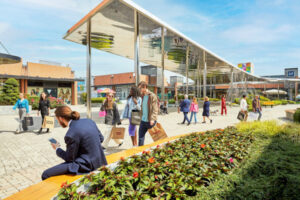BY JÖRG F. BITZER
The fact remains that simply putting one retail area beside one another or its solitary location are no longer enough for stationary retail to retain its customers.
Entertainment, infotainment, quality of stay, and recreational activities are just a few of the buzzwords that have to be implemented by retailers as well as center operators to successfully withstand the “I-order-it-from-my-couch-on-Sunday-night” phenomenon in their daily competition.
The shopping experience as a substantial factor
Integrating gastronomy into the shopping experience is a substantial factor for this goal. For example, not only the worldwide operating furniture group IKEA recognized this development and already generates an annual turnover of €1.5 billion by selling hot dogs, “Köttbullar” and other foods alone.
Hypermarket chains like Real in Germany or Tesco in Great Britain and Central Europe also try to significantly increase lengths of stay in their respective stores with integrated gastronomy concepts. Furniture stores all over Europe follow the large Swedish retailer’s example and invite their customers (often at subsidized prices) to enjoy up to 4 meals per day with special offers mostly on their top shopping floors and therefore increase frequencies on all of their shopping floors at clearly measurable rates.
If the integration of gastronomy concepts into the retail sector is already an absolute must for international retail chains, it is even more important for shopping center operators to merge retail and gastronomy into “Gastrotail”: More and more operators move on from classic Foodcourts, which can only offer their visitors an impersonal fast-food break for a few minutes, to market hall concepts, street food markets, and themed restaurants of the highest category.
It is no longer the goal to be able to eat a snack along the way while you shop. Restaurants become actual “destination points” for customers. The higher the quality and the more unique gastronomy concepts are, the stronger the USP for the respective shopping center, the easier the competition against the previously mentioned “Sunday-night-couch-purchase-decision-via-smartphone” becomes.
Expansion of gastronomy areas
Shopping center operators all over Europe have recognized this trend and expand their gastronomy areas consistently and increasingly. 10 years ago, 10% was the standard ratio for gastronomy areas. Today, many refurbished and new centers have already expanded this ratio to 20% for their customers – and there does not seem to be an end in sight for this trend.
Specified, unique gastronomy concepts, like the one provided by the Italian operator Eataly across Europe since 2007, are perfect examples for the successful integration of shopping and gastronomy. These concepts are the future in a market in which consumers long for experiences when they visit “shopping hot spots”.
It is not possible to simulate the sensations of feeling, smelling, tasting, and haptical touching on the Internet. One can only realize these sensations in a way that increases lengths of stay in a corresponding environment.
The additional fact that “you can’t do business with a hungry customer” is also a very pleasant side effect for center operators as well as retailers!
What is your opinion on this topic? Discuss it with us! Send your opinion to opinion@across-magazine.com






